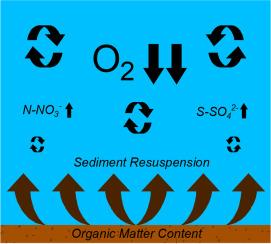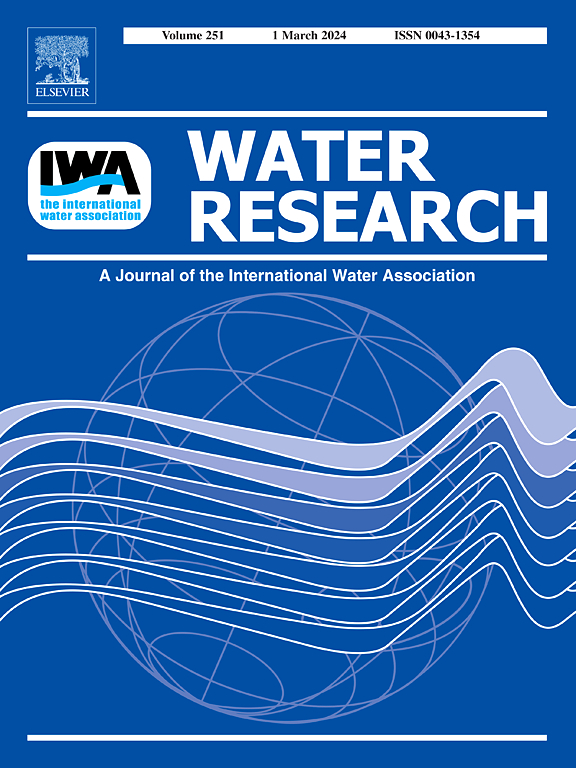Aquatic deoxygenation associated with resuspension of anthropogenic organic matter
IF 11.4
1区 环境科学与生态学
Q1 ENGINEERING, ENVIRONMENTAL
引用次数: 0
Abstract
Aquatic environments are highly polluted due to the anthropogenic pressures associated with large populations. Among these ecosystems, coastal lagoons are particularly sensitive to anthropogenic disturbances. The Mar Menor is an example of such an ecosystem, with an extremely degraded status with high levels of anthropogenic eutrophication. As a consequence, reduced dissolved oxygen levels have been observed in this lagoon following episodic wind events that induce mixing and resuspension of bottom sediments, leading to catastrophic consequences for fish populations. Therefore, understanding the processes that control the oxygen depletion in lagoon waters is thus essential to appropriately manage the ecosystem. This study analyses oxygen consumption in the water column associated with sediment resuspension events induced by wind. The study was carried out in a laboratory, where mixing was induced using an oscillating grid device. The range of mixing intensities were selected to be close to the turbulence encountered in the lagoon's field conditions. The resuspended sediment used for the experiments had been taken from the bed of the Mar Menor at three sampling sites. The results of this study indicate that oxygen depletion in the water column during mixing increases with the amount of sediment resuspended, the mean diameter of the particles and the organic matter content in the sediment bed. Data on oxygen depletion in coastal lagoons, estuaries, seas, and reservoirs were then used to develop a predictive model for oxygen depletion, based on the concentration of resuspended sediment, its characteristic particle diameter, and the organic matter content of the sediment bed. Organic matter content was found to be the most significant factor contributing to oxygen depletion. The resulting model determines the oxygen depletion associated to sediment resuspension events with sediments affected by anthropogenic eutrophication.


求助全文
约1分钟内获得全文
求助全文
来源期刊

Water Research
环境科学-工程:环境
CiteScore
20.80
自引率
9.40%
发文量
1307
审稿时长
38 days
期刊介绍:
Water Research, along with its open access companion journal Water Research X, serves as a platform for publishing original research papers covering various aspects of the science and technology related to the anthropogenic water cycle, water quality, and its management worldwide. The audience targeted by the journal comprises biologists, chemical engineers, chemists, civil engineers, environmental engineers, limnologists, and microbiologists. The scope of the journal include:
•Treatment processes for water and wastewaters (municipal, agricultural, industrial, and on-site treatment), including resource recovery and residuals management;
•Urban hydrology including sewer systems, stormwater management, and green infrastructure;
•Drinking water treatment and distribution;
•Potable and non-potable water reuse;
•Sanitation, public health, and risk assessment;
•Anaerobic digestion, solid and hazardous waste management, including source characterization and the effects and control of leachates and gaseous emissions;
•Contaminants (chemical, microbial, anthropogenic particles such as nanoparticles or microplastics) and related water quality sensing, monitoring, fate, and assessment;
•Anthropogenic impacts on inland, tidal, coastal and urban waters, focusing on surface and ground waters, and point and non-point sources of pollution;
•Environmental restoration, linked to surface water, groundwater and groundwater remediation;
•Analysis of the interfaces between sediments and water, and between water and atmosphere, focusing specifically on anthropogenic impacts;
•Mathematical modelling, systems analysis, machine learning, and beneficial use of big data related to the anthropogenic water cycle;
•Socio-economic, policy, and regulations studies.
 求助内容:
求助内容: 应助结果提醒方式:
应助结果提醒方式:


